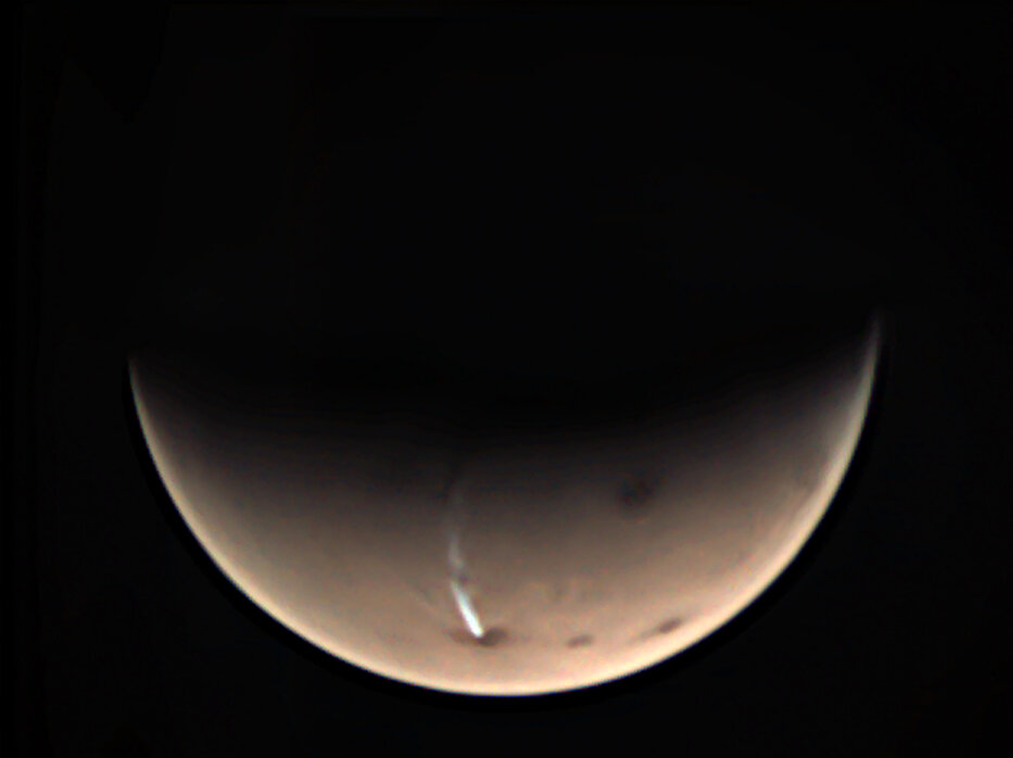Mysterious Martian cloud reappears above Arsia Mons volcano
The cloud made an appearance over the volcano before, in 2018

Your support helps us to tell the story
From reproductive rights to climate change to Big Tech, The Independent is on the ground when the story is developing. Whether it's investigating the financials of Elon Musk's pro-Trump PAC or producing our latest documentary, 'The A Word', which shines a light on the American women fighting for reproductive rights, we know how important it is to parse out the facts from the messaging.
At such a critical moment in US history, we need reporters on the ground. Your donation allows us to keep sending journalists to speak to both sides of the story.
The Independent is trusted by Americans across the entire political spectrum. And unlike many other quality news outlets, we choose not to lock Americans out of our reporting and analysis with paywalls. We believe quality journalism should be available to everyone, paid for by those who can afford it.
Your support makes all the difference.A mysterious long, thin cloud has made another appearance over a volcano in Mars.
The gaseous body was seen floating over the 20-kilometer high Arsia Mons volcano on the Red Planet, in images captured by the ESA.
The volcano itself has not been active for 50 million years, so it is incredibly unlikely that it is the cause of the cloud.
The cloud is made up of water ice, but does not seem to be from volcanic activity. The stream forms as the airflow is influenced by the side of the volcano that does not face the wind, baffling scientists.
It has been named Arsia Mons Elongated Cloud (AMEC), but the mysteries of why it is formed, and for how long it has been appearing and disappearing, are still unknown.
“We have been investigating this intriguing phenomenon and were expecting to see such a cloud form around now,” explains Jorge Hernandez-Bernal, PhD candidate at the University of the Basque Country.
“This elongated cloud forms every Martian year during this season around the southern solstice, and repeats for 80 days or even more, following a rapid daily cycle. However, we don’t know yet if the clouds are always quite this impressive”.
A Martian year is approximately 687 Earth days. The southern solstice is when the Sun is in the southernmost area of the sky. During this period, in the early morning, the cloud grows for three hours before quickly disappearing again.
This is not the first time the cloud has made an appearance. The strange cloud was seen in 2018 where it stretched over 1,500km of the planet’s surface in late September, before disappearing in mid-October.
Most spacecraft orbiting Mars only make observations in the afternoon, but the image of this cloud can be captured by the Mars Express – launched in 2003 – because it is in a high elliptical orbit.
“The extent of this huge cloud can't be seen if your camera only has a narrow field of view, or if you're only observing in the afternoon” said Eleni Ravanis, who works with the camera equipment on the Mars Express.
The craft’s high orbit, “coupled with the wide field of view of the VMC instrument [this] lets us take pictures covering a wide area of the planet in the early morning”, Ravanis continued.
Join our commenting forum
Join thought-provoking conversations, follow other Independent readers and see their replies
Comments